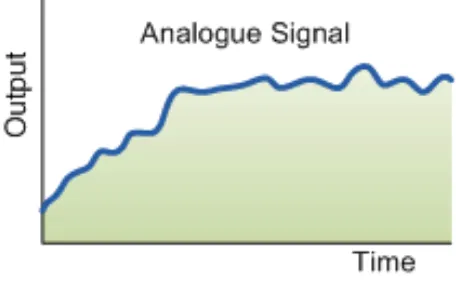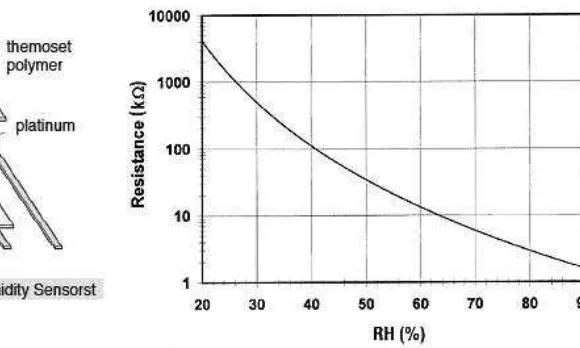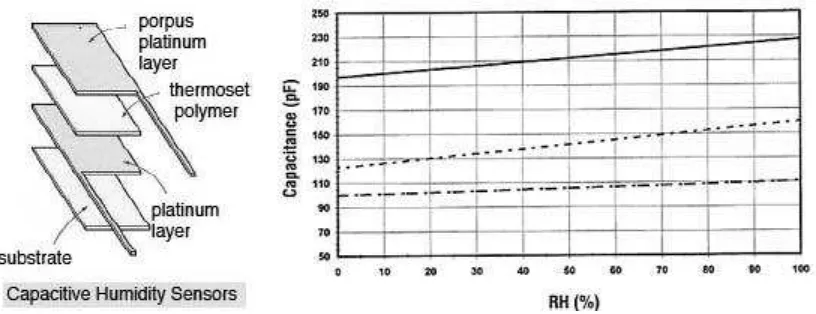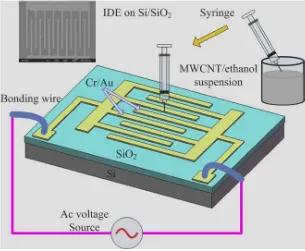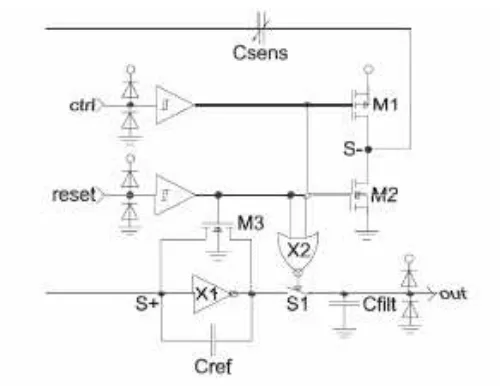DEVELOPMENT OF HYDRO-ATOMIZED SPRAYING SYSTEM FOR A CONTROLLED ENVIRONMENT AEROPONIC FARM
LIM JIA QI
A report submitted in partial fulfillment of the requirements for the degree of Bachelor of Mechatronic Engineering
Faculty of Electrical Engineering
UNIVERSITI TEKNIKAL MALAYSIA MELAKA
I declare that this report entitle “DEVELOPMENT OF HYDRO-ATOMIZED SPRAYING SYSTEM FOR A CONTROLLED ENVIRONMENT AEROPONIC FARM” is the result of my own research except as cited in the references. The report has not been accepted for any degree and is not concurrently submitted in candidature of any other degree.
Signature : ...
Name : LIM JIA QI
ACKNOWLEDGEMENT
ABSTRACT
ABSTRAK
Table of content
List of equation ... viii
List of table ... ix
List of chart ... x
Chapter 1 ... 1
1 Introduction ... 1
1.1 Project background ... 1
1.2 Problem statement... 1
1.3 Objective ... 2
2.2.1.1 Resistive humidity sensor ... 6
2.2.1.2 Capacitive humidity sensor ... 7
2.3 Comparison study ... 8
2.3.1 Sensor study ... 8
2.3.1.1 Table comparison ... 13
2.3.3 Conclusion ... 15
3.4 Project implementation flow chart ... 19
3.5 System flow chart ... 20
3.6 Component used ... 22
3.6.1 Microcontroller ... 22
3.6.2 SK40C ... 23
3.6.3 Transistor 2N2222 ... 23
3.6.4 Relay ... 24
3.6.5 DC pump ... 24
3.7 Software... 25
3.7.1 Microcontroller ... 25
3.7.2 Hardware design ... 27
4.1 Result for experiment on investigation of 2 different types of controller which is timer controller and sensor controller in spraying performance. ... 35
4.2 Result for observation to the ability of the acrylic hardware to maintain a moisture level at different temperatures. ... 37
Chapter 5 ... 41
5 Conclusion ... 41
5.1 Recommendation ... 42
Reference ... 43
List of figure
Figure 2.1 Analogue sensor output ... 5
Figure 2.2 The exponential response of resistive sensor ... 6
Figure 2.3 A near linear response of capacitance changes vs humidity at 25˚C ... 7
Figure 2.4 Resistive-relative humidity data and linear fit of a MWCNT network obtained at room temperature[6]. ... 9
Figure 2.5 Schematic diagram of MWCNT deposition on IDEs by ac dielectrophoresis to increase sensitivity of sensor [6]. ... 9
Figure 2.6 Schematic diagram for capacitive humidity sensor... 11
Figure 2.7 Schematic diagram for CMOS sensor ... 11
Figure 2.8 Output voltage vs relative humidity for CMOS sensor ... 12
Figure 2.9 Others experiment data summarized ... 12
Figure 2.10 Spraying pattern at different pressure ... 15
Figure 3.1 System overview ... 16
Figure 3.2 K-chart ... 17
Figure 3.3 Project implementation flow chart ... 19
Figure 3.4 System flow chart i ... 20
Figure 3.5 System flow chart ii ... 21
Figure 3.6 System flow chart iii ... 21
Figure 3.7 PIC 16F877a ... 22
Figure 3.8 Omron MY2J relay ... 24
Figure 3.9 Basic circuit simulation ... 25
Figure 3.10 Relay & Transistor simulation circuit ... 26
Figure 3.11 Solidwork design... 27
Figure 3.12 Acrylic Hardware ... 28
Figure 3.13 Circuit set-up ... 29
Figure 3.14 Sensor & nozzles ... 30
Figure 3.15 Pump & pipe connection ... 30
Figure 4.1 Timer controller versus sensor controller ... 35
Figure 4.2 Humidity at different temperature ... 37
List of equation
List of table
List of chart
Chapter 1
1
Introduction
1.1 Project background
Aeroponic is a type of plantation process that grows plants in air or mist environment without using any soil or aggregate medium. Unlike hydroponic, aeroponic did not use water as growing medium. In hydroponic, plant’s roots are submerged into water to get water and nutrient to support its life. But for aeroponic, the nutrient is supply through mist spray by sprinkles or nozzles to plant’s roots.
An aeroponic farm system can set up with a few main components like a pump, nozzles, and growing chamber. There are a few types of aeroponic currently exist like low pressure type, high pressure type and commercial system. Different type of aeroponic required different kind of component to set up but the working concept is about the same.
1.2 Problem statement
Urban residents face limited space problem, especially for those living in apartments and condominiums. It is impossible for them to undergo conventional faming in their housing area. Traditional flower pot might be able to plant, but the harvest is limited. In order to get desire quantity of harvest, a number of flower pots are needed. This will eventually make the space problem worse.
Domestic aeroponic farming system uses timer to control spraying period. The timer will activate the system following the pre-set time regardless of the condition inside the chamber. The timer will still activate the spraying system after a time interval even though the humidity and moisture level inside the chamber is saturated. In this way, the system has low reliability.
1.3 Objective
1) To develop a home use farming system as an alternative way to farming, by applying mechatronic system.
2) To develop an automatic spraying system that is able to give feedback to aeroponic system by using microcontroller and sensor.
3) To control the nutrients release and moisture fed to the roots of plant.
4) To investigate relationship between humidity and time with different spraying interval.
1.4 Scope
Chapter 2
2
Literature review
2.1 Introduction
In this section, sensor theory and literature review will be delivered. Sensor is a device used to measure or determine physical quantity so that we can manipulate these physical quantities. Sensors can be divided into 2 groups, digital and analogue. Either digital or analogue sensor, both have the same function. The difference is the output of the sensors. In this section, only the analogue sensor is studied.
Next, this is the study of the humidity sensor. After studying a number of relevant topic paper, three papers are chosen to compare the performance of humidity sensor[1]. The sensors that are compared are analogue capacitive type and analogue resistive type.
2.2 Theory and mechanism
2.2.1 Analogue sensor
An analogue sensor is a type of sensor that produce a continuous output signal or voltage that is proportional to the measurement quantity. There are many types of analogue quantities in the nature such as temperature, speed, pressure humidity etc[2].
Analogue sensors measure analogue signals by using different parameter like resistance, capacitance, thermal conductivity etc. The output of the sensor are smooth and continuous signals[3]. Figure 2-1 shows the output signal of an analogue sensor.
Figure 2.1 Analogue sensor output
2.2.1.1 Resistive humidity sensor
Resistive humidity sensors measure the changes in electrical impedance of a hygroscopic medium such as a conductive polymer, salt, or treated substrate. Resistive sensors normally consist of noble metal electrodes. A resistive humidity sensor detects relative humidity by measuring the change in the resistance of an element corresponding to the ambient humidity. Salt or conductive polymer is coated on the substrate and when it is melted or suspended in a liquid binder, it will equally coat the sensor. The substrate may be treated with activating chemicals such as acid. The sensor absorbs the water vapour and ionic functional groups are disassociated, resulting in an increase in electrical conductivity. The impedance change is typically an inverse exponential relationship to humidity as shown in Figure 2-2[1].
2.2.1.2 Capacitive humidity sensor
Capacitive relative humidity (RH) sensors made up of a substrate on which a thin film of polymer or metal oxide is placed between two conductive electrodes. The sensing surface is coated with a porous metal electrode to protect it from contamination and contact to condensation. Typically the substrate is glass, ceramic, or silicon. The variation in the dielectric constant of a capacitive humidity sensor is approximately directly proportional to the relative humidity of the surrounding atmosphere as shown in Figure 2-3. Typically the change in capacitance is 0.2–0.5 pF for a 1% RH change, while the bulk capacitance is around 100 to 500 pF at 50% RH at 25°C. This type of sensor is characterized by low temperature coefficient, ability to function at high temperatures (up to 200°C), full recovery from condensation, and reasonable resistance to chemical vapors[1].
2.3 Comparison study
2.3.1 Sensor study
1)Humidity sensitivity of Multi-Walled Carbon Nanotube Networks Deposited by Dielectrophoresis
An investigation on the humidity sensitivity of deposited multi-walled carbon nanotube network using ac dielectrophoresis is presented. A type of material call Carbon nanotubes (CNT) was deposited on the electrode of the resistive type humidity sensor. Dielectrophoreisis is a method to deposit and align CNTs on electrodes of the sensor. The purpose of this deposition of carbon nanotubes is to improve the performance of a resistive type humidity sensor [6].
Figure 2.4 Resistive-relative humidity data and linear fit of a MWCNT network obtained at room temperature[6].
2)A Capacitive Humidity Sensor Based on Multi-Wall Carbon Nanotubes
An new type of capacitive humidity sensor with two plate electrodes coated with multi-wall carbon nanotubes film and four pieces of isolating medium at four corners of the sensor is introduced. This type of sensor used capillary condensation concept to determine relative humidity. The dielectric constant of the sensor will change due to the condensation of the water modules and hence the capacity of the sensor is varying at different relative humidity level[7]. For an increase in humidity, the water molecules tend to condense in capillary pores in the film with a radius below the
Kelvin radius r, which is defined as function[7] :
Equation 1 Kelvin radius equation
θ–Contact angle of liquor and wall of capillary pore.
VL–The molecular volume of liquor.
γ–The surface tension of liquor.
R–Gas constant (R = 8.314 J × (mol × K)-1). T–Absolute temperature (K).
r–Kelvin radius of the capillary pores.
The RH increase dramatically when the Kelvin radius increase.
The experiment in the study about the response and recovery time is done at room temperature at two relative humidity points: 11 %( RH) and 86 %( RH). The response time is 45 s and the recovery time is 15 s[7].
Figure 2.6 Schematic diagram for capacitive humidity senso
3)A standard CMOS humidity sensor without post-processing
A capacitive humidity sensor was developed by using CMOS technology without post-processing. The paper discusses the problem to overcome in order to integrating humidity sensor in CMOS. To integrating humidity seonsors in CMOS, the most suitable approach is sensing the humidity with hygroscopic polymer films. An electrical flux must be confined to the hygroscopic film in order to get a large relative capacitance change. Therefore a woven lateral array of electrodes implemented in it, and capacitance –to-voltage on chip converter is implemented as well[9].
